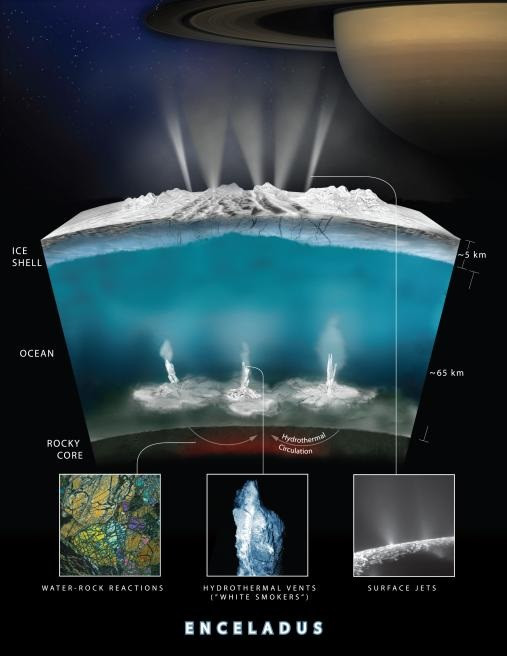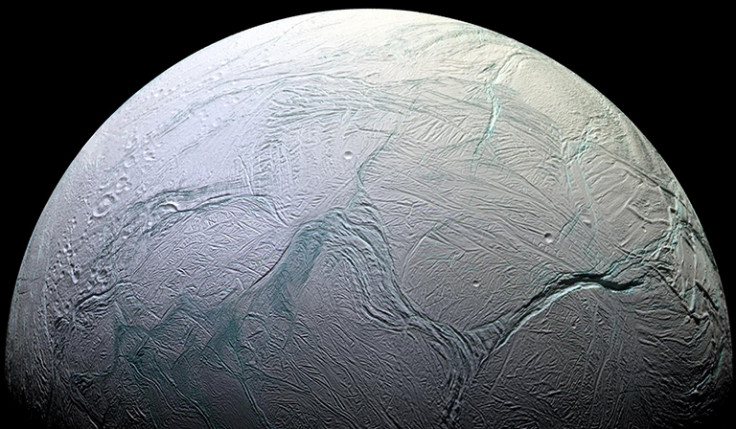Nasa says Saturn's moon Enceladus and Jupiter's moon Europa could support alien life
Plumes of hydrogen spurting through ice could support life on one of Saturn's 53 moons.
Nasa has announced that one of Saturn's icy moons could be supporting alien life in our solar system after discovering hydrogen spurting from the surface.
Scientists behind Nasa's Cassini spacecraft mission to Saturn have observed huge plumes of water emanating from cracks on Saturn's sixth largest moon.
In orbit around Saturn since 2004, Cassini has been taking pictures of Enceladus, described as an "active ocean world" by experts, with an icy cap around 5km thick and vast oceans believed to be underneath.
In an announcement made via a teleconference on Thursday (13 April) held at the agency's headquarters in Washington DC, Cassini scientists talked about their discovery to the world and also discussed Europa, a moon orbiting Jupiter may also be emitting hydrogen.
They said images captured huge plumes being shot out of the surface of Enceladus. The spacecraft took readings of the water and sent them back to Earth for further study.
Scientists say the plumes, containing hydrogen gas, which could potentially provide a chemical energy source for life, is pouring into the subsurface ocean.
They believe that this could emanate from vents on the ocean floor, similar to those that appear in Earth's deep oceans.
Experts say the presence of ample hydrogen in the moon's ocean means that microbes, if any exist on the moon, could use it to obtain energy by combining the hydrogen with carbon dioxide dissolved in the water.
This chemical reaction, known as "methanogenesis" produces methane as a byproduct, which Nasa says is "at the root of the tree of life on Earth".
Mary Voytek, astrobiology senior scientist at Nasa headquarters, said: "Certainly this finding suggests that there is a significant amount of hydrothermal activity ... and this hydrogen is a good source of chemical energy to support life."
Linda Spilker, Cassini project scientist at NASA's Jet Propulsion Laboratory in Pasadena, California said the most significant plumes were emanating from four large 'tiger stripes' on the south pole of the moon.
The discoveries were made with the assistance of the Hubble Space Telescope and will guide future missions to explore other worlds for extra-terrestrial life, Nasa said in a statement.

Chris Glein, Cassini INMS team associate at SwRI added: "We haven't discovered evidence of organisms on Enceladus but I'm encouraged by the geochemical data which could allow for this possibility."
Spikler concedes that a further mission with as-of-yet unbuilt technology will be needed to examine the oceans underneath Enceladus.

Jim Green, director, Planetary Science Division at NASA Headquarters made another announcement thanks to the Hubble telescope about possible hydrogen emitting from Europa, one of the four moons orbiting Jupiter.
Plumes and hot spots
William Sparks, astronomer with the Space Telescope Science Institute in Baltimore, said his team had combined data from the Galileo space mission and the Hubble space telescope where they found a hot spot underneath the surface where a hot plume had come from.
A plume in 2016 rose to about 100km above Europa's surface, while another observed in 2014 was estimated to be about 50km high.
Both correspond to the location of an unusually warm region that contains features that appear to be cracks in the moon's icy crust, seen in the late 1990s by NASA's Galileo spacecraft.
"The plumes on Enceladus are associated with hotter regions, so after Hubble imaged this new plume-like feature on Europa, we looked at that location on the Galileo thermal map. We discovered that Europa's plume candidate is sitting right on the thermal anomaly," said Sparks.
Cassini will run out of fuel on 15 September but a new mission - the Europa clipper - will go to Enceladus with nine major instruments on board in the 2020's.
"If there are plumes on Europa, as we now strongly suspect, with the Europa Clipper we will be ready for them," said Jim Green, Director of Planetary Science, at NASA Headquarters.
Cassini scientist Dr Hunter Waite from the Southwest Research Institute in Texas said: "#We are pretty darn sure that the internal ocean of Enceladus is habitable and we need to go back and investigate it further."
He told the BBC: "If there is no life there, why not? And if there is, all the better. But you certainly want to ask the question because it's almost as equally as interesting if there is no life there, given the conditions."
© Copyright IBTimes 2025. All rights reserved.






















